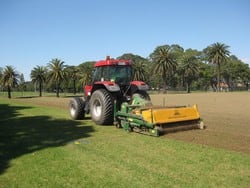Green grass and spacious lawns are one of the features of public parklands that people most love for their sport and leisure activities. Turf management is an essential aspect of managing public parklands, but one that most people would never think too much about.
There are a range of issues that we deal with in successfully maintaining grass areas across Centennial Parklands, including species, length, usage pattern, weed management, wildlife attraction and maintenance costs.
What types of grass are found across Centennial Parklands?
A number of different turf grass species can be found across Centennial Parklands:
- Kikuyu (Pennisetum clandestinum) is a vigorous ground-hugging grass which spreads by runners. It is mostly active in the warm months.
- Ryegrass (Lolium perenne) is a tuft forming grass that is frequently used for lawns and can be used to control soil erosion. It is mostly active in cooler months.
- Couch (Cynodon dactylon) is a low-growing turf grass with narrow grey-green leaves and runners which root readily. It is mostly active in the warm months.
Why is grass length an issue?
Grass length is a subject that generates much conflicting debate and discussion in the community – as has been revealed by the Trust’s triennial park users surveys.
The Trust is mindful of differing views of experts and the community and uses a mixed model of grass length – or a ‘mosaic’ approach - to suit the particular circumstances and usage patterns of the grass.
For example, grass on sporting fields is kept short as required by the nature of its use, while grass on sloped surfaces (eg. banks and hill sides) is generally left a little longer to minimise erosion resulting from stormwater runoff and the effects of constant heavy machinery running over the surface.
Not mowing grass can also provide the opportunity for the reintroduction of native plant species (such as Kangaroo and Wallaby Grass) that may have residual seeds in the soil.
The Trust also takes a slightly different approach to turf length in the distinctive zones within the Parklands.
For example, the Column and Rose Gardens are manicured and more formal landscape settings, so the grass is mown low and smooth, while areas around Sandstone Ridge and Ash Paddock are more naturalistic in their setting and the grass is left long to complement surrounds. Tufting species are more evident in these areas.
How does grass length impact upon weed management?
 A weed can be defined as ‘any plant out of place’. Many weeds typically found in the Sydney region (including Centennial Parklands) are introduced plants that have few predators and usually produce large amounts of seed, and so out-compete or smother native plants. Some herbaceous weeds are able to grow in lawns and grassed areas.
A weed can be defined as ‘any plant out of place’. Many weeds typically found in the Sydney region (including Centennial Parklands) are introduced plants that have few predators and usually produce large amounts of seed, and so out-compete or smother native plants. Some herbaceous weeds are able to grow in lawns and grassed areas.
Weeds that are commonly found in Centennial Parklands include clover, Crab Grass, Cape Weed, Bella Donna and Cobblers Pegs. There are also some very invasive tall tufting grasses from South Africa that enjoy growing in our sandy soil and warm coastal climate.
Frequent mowing eliminates many of these weeds by preventing them from flowering and setting seed.
However other weeds such as Bindii (Soliva pterosperma), that grow at ground level aren’t affected by mowing. To eliminate these weeds, the Trust undertakes an annual herbicide spraying program. The herbicides we use are carefully targeted, are safe to use in the environment, and have no enduring breakdown products that would be harmful to birds, animals, fish or reptiles.
What impacts does grass mowing have on the wildlife?
Many native bird species that visit the Parklands, such as cockatoos, little corellas, galahs and budgerigars, are attracted by certain grass species. Leaving grass longer and allowing it to flower and set seed acts as an attractant to such wildlife and contributes to overall biodiversity.
How does differing grass maintenance techniques benefit maintenance costs?
The Trust has opted for a mosaic approach to grass maintenance for the reasons explained above, and this also has the added benefit of cost savings to the Parklands.
These cost savings are achieved by reducing the petrol consumption of the Trust’s mowers and reduced labour costs as a result of more efficient mowing regimes.